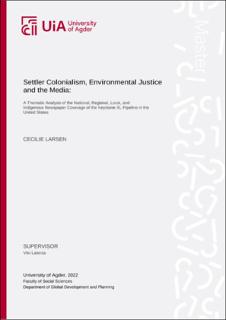| dc.description.abstract | Purpose - The purpose of this thesis is to explore what thematic frames national, regional, local, and Indigenous newspapers have used when reporting on the Keystone XL pipeline in the United States. Specifically, by analyzing the newspaper articles which were published in six different newspapers, the New York Times, Wall Street Journal, Los Angeles Times, Omaha World-Herald, Lincoln Journal Star, and Indian Country Today, over the course of 12 months, this thesis discusses to what extent the media coverage can be an example of settler colonialism as the conflict surrounding the Keystone XL has largely been located to Indigenous land across several states, including Nebraska.
Methodology – By using collected data from newspaper articles, this thesis processed more than 200 articles which included the search term “Keystone XL” in order to label the various articles with a thematic frame. Multiple frames could be used in any given article, but one main frame was assigned to each article. The descriptive statistics break down the different thematic frames per newspaper. Then, excerpts from the different articles were extracted and prescribed into the four main thematic frames that emerged from the analysis. Each thematic frame also contains sub-themes which support the overall main thematic frame.
Findings – Four main thematic frames were identified in the newspaper coverage of the Keystone XL pipeline: ‘Politics and Economy’, ‘Climate’, ‘Grassroots Mobilization and Indigenous Opposition’, and ‘Foreign relations.’ The thematic frames contextualize the dispute surrounding the expansion of the Keystone XL oil pipeline in different manners, in the different newspapers to cater to the different audiences. Notably, it was mainly the local and regional newspapers in Nebraska which reported on the local opposition and the alliance of white farmers, landowners, environmentalists, and Indigenous people.
Originality – This thesis uses the Keystone XL pipeline as a case for studying settler colonialism in American newspapers, by arguing that settler colonialism is more than physical land acquisition and genocide. The way settler media refers to ecological violence on native land are present-day forms of settler colonialism. Acknowledging this is an important step both towards decolonization, and to work for environmental justice for Indigenous communities.
Keywords: settler colonialism, Keystone XL pipeline, Nebraska, ecological violence, grassroots mobilization, environmental justice, energy infrastructure, newspaper coverage, thematic analysis | |
